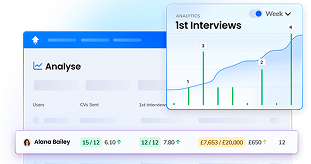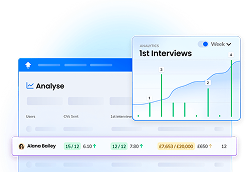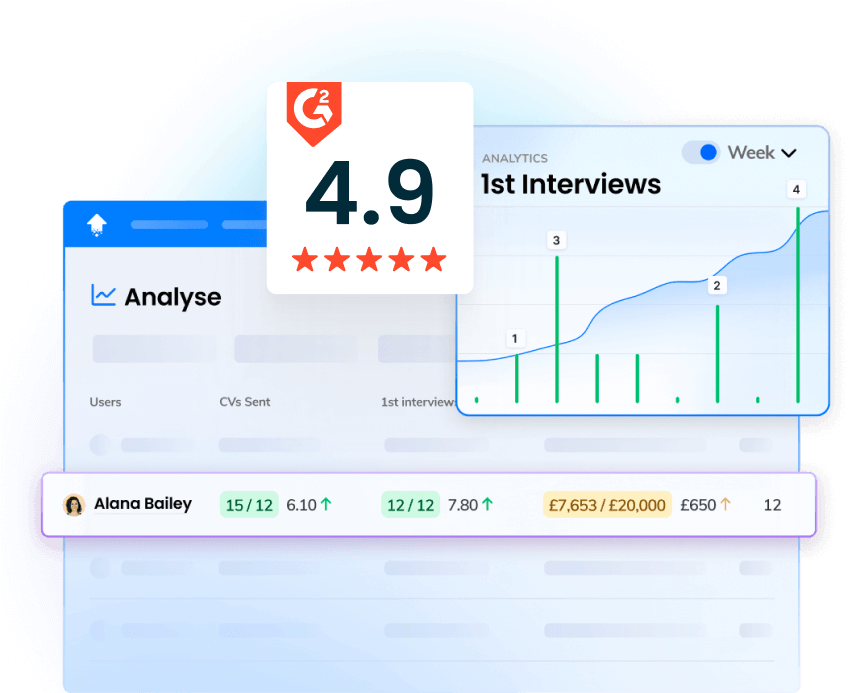When talent mapping, recruitment agencies identify, assess, and track potential candidates for future roles.
This proactive strategy involves gathering market intelligence, understanding competitor hiring trends, and building a pipeline of skilled professionals.
So why do agencies perform talent mapping?
To gain access to the right talent when needed.
Indeed, agencies that don't engage in talent mapping often struggle with slow hiring cycles.
These delays make sense — after all, they only start sourcing when a role becomes vacant.
What's more, without talent mapping, high sourcing costs arise due to last-minute hiring efforts, reliance on job ads, and costly external searches.
Ultimately, reactive recruitment limits agencies to a narrow candidate pool, increasing competition and reducing hiring success.
But by leveraging data-driven talent mapping, agencies can adopt a sustainable, proactive hiring strategy.
This approach enables them to identify top talent early, nurture relationships, and fill roles quickly with pre-vetted candidates.
It also reduces recruitment costs, improves client satisfaction, and enhances their ability to attract a continuous flow of high-quality professionals ready for immediate or future opportunities.
What is Talent Mapping In Recruitment?
In years gone by, recruiters would practice reactive sourcing.
An open job would be added, and then — and only then — would they start hunting for the right candidate to fit it.
But traditional sourcing is no longer enough to remain competitive in today's challenging recruitment landscape.
What if you could have the perfect candidate ready to go the second the job is added?
This is where talent mapping comes in.
Talent mapping is the strategic process of proactively identifying, assessing, segmenting, and tracking potential candidates for future hiring needs.
And, in 2025, data plays a huge role in ensuring talent mapping efforts are accurate and effective.
Indeed, by leveraging real-time data, recruitment teams are empowered to anticipate hiring needs, engage with top talent early, and build strong relationships before vacancies arise.
To summarise, a structured, data-driven talent mapping process creates a sustainable, efficient pipeline of skilled professionals ready for future opportunities.
Benefits of Talent Mapping for Recruitment Agencies
So, what are the benefits of using real-time data to supercharge your talent mapping strategy?
- Reduced time-to-hire — If you have the perfect candidate to submit before a role opens, your time-to-hire metric should plummet.
- Lower hiring costs — With talent mapping, you're less reliant on job boards and paid sourcing, so your agency should save on fees.
- Happier clients — When your recruitment agency offers strategic workforce planning services rather than transactional hiring alone, you should build stronger relationships with clients and see customer satisfaction rocket.
- Better diversity hiring — With talent mapping, you can proactively track diverse talent pools to help your clients build stronger, more effective teams.
- A more refined strategy — Real-time data insights constantly show you what's working and what's not, empowering you to continuously refine your recruitment strategy.
The 5-Step Talent Mapping Process for Recruitment Agencies
Wondering how to do talent mapping in recruitment?
You're in luck.
Read on for our straightforward five-step talent mapping process.
Step 1 – Define Talent Needs & Market Trends
Begin by defining your talent needs and market trends.
Recruitment analytics tools come in very handy here.
You'll need to gather and analyse historic and current industry data and internal results to predict a future talent gap.
It's also important to read up on the latest recruitment surveys and trending articles in your niche:
- What predictions are hiring managers making for the coming months?
- What tech trends are set to impact your industry?
- Which jobs are going out of fashion?
You can also use your internal data alongside predictive analytics to forecast the next big thing.
However, no one has a better idea of your clients' specific talent needs than your clients themselves.
This means it's crucial to regularly sit down with your clients to forecast their hiring needs six to 12 months ahead.
Combine this qualitative and quantitative research, and you should have all the info you need to start building and segmenting a talent pool.
Step 2 – Build & Segment a Talent Pool
Building and segmenting a talent pool is all about staying ahead of the game.
Start by gathering potential candidates from job applications, networking events, referrals, and online platforms — think of it as creating a database of great people you'd love to hire one day.
Ensure you track their skills, experience, career goals, and availability.
To keep things organised, segment your talent pool based on criteria including:
- Skills and competencies
- Industry and role relevance
- Geographic availability
- Seniority level (entry, mid, executive)
- Active or passive candidates
Performing segmentation manually would take way too long, so use OneUp's recruitment analytics suite to categorise your talent.
Step 3 – Engage Passive Candidates
The key to a successful talent pool is engagement.
This means keeping in touch with active and passive candidates through personalised messages, industry updates, and career development opportunities.
That way, when the perfect role comes up, you've already got a warm, engaged group of candidates ready to go.
However, engaging passive candidates is typically trickier than connecting with keen applicants who are actively looking for work.
Passive candidates may not be looking for work right now, but they might be open to a new opportunity should the right job come along.
To keep passive candidates engaged, try running email campaigns with helpful industry insights and job round-ups.
In 2025, LinkedIn nurture campaigns are one of the most useful tools in your hiring arsenal.
A typical LinkedIn nurture campaign might look something like this:
➡️ Week 1: Personalised Connection Request
"Hi [Candidate's Name], I came across your profile and was really impressed by your experience in [specific skill/industry]. I'd love to connect and stay in touch—hope you're open to it!"
➡️ Week 2: Thought Leadership Share
"Hi [Candidate's Name], I saw this article on [topic relevant to their expertise] and thought you might find it interesting! Curious to hear your thoughts—always great to connect with like-minded professionals."
➡️ Week 3: Soft Introduction To Your Company
"Hey [Candidate's Name], I know you're not actively looking, but I wanted to share this story about how we do [company initiative or value]. It reminded me of our last chat—thought you'd appreciate it!"
➡️ Week 4: Informal Coffee Chat Invitation
By now, your candidate is more familiar with you, so you can introduce a casual chat.
"Hi [Candidate's Name], I've really enjoyed our chats! No pressure, but if you're ever open to hearing more about exciting opportunities at [Company Name], I'd love to grab a virtual coffee and learn more about what excites you in a role."
You must also automate check-ins every three-to-six months to ensure the candidate doesn't forget about you.
These check-ins could be by email, text, or LinkedIn messaging.
Step 4 – Track & Analyse Talent Readiness
As with every recruitment process in 2025, tracking and analysing data is crucial to success.
At the beginning of your talent mapping process, it's essential to set recruiting OKRs and SMART goals.
SMART goals are:
- Specific
- Measurable
- Achievable
- Relevant
- Time-bound
You should then use data analytics — for example, OneUp's custom dashboards or reports — to track metrics relevant to your goals and measure progress.
For example, you can measure candidate readiness through:
- Engagement metrics
- Job searches
- Availability updates
You can also track the success of your engagement campaigns via the following metrics:
- LinkedIn connection acceptance rate
- Message response rate
- Email open rate
- Email reply rate (where relevant)
- Email click-through rate
- Content engagement (Likes, Comments, Shares)
- Informal chat/meeting rate
- Talent pool growth
- Application rate – Percentage of nurtured candidates who eventually apply for a role
- Hire rate from passive candidates – The number of hires from your nurture campaign.
Step 5 – Convert Talent Pool into Placements
A proactive and data-driven recruitment approach is vital here.
When a client has an opening, the key is to act fast — instantly matching them with pre-vetted candidates from your talent pool.
This reduces time-to-hire and ensures a smoother recruitment process.
Furthermore, using data-driven hiring decisions improves matches and minimises placement risks.
Indeed, by leveraging insights on candidate experience, skills, and past performance, recruiters can make informed choices, ensuring a better fit for both clients and candidates.
In 2025, AI-based candidate scoring can significantly improve your results.
This advanced tech streamlines the process by prioritising top candidates based on factors like qualifications, cultural fit, and engagement levels.
This allows recruiters to focus on the best-suited individuals first, increasing the chances of a successful placement.
So, by combining speed, data, and technology, recruiters can turn their talent pool into a powerful asset, securing high-quality hires while strengthening relationships with clients and candidates alike.
The Role of Technology & Automation in Talent Mapping
Talent mapping without sophisticated tech is a long and arduous process.
Fortunately, there are tools on the market designed to help recruitment agencies gather, organise, and analyse talent data efficiently.
Instead of relying on outdated spreadsheets or manual tracking, agencies can leverage various tech applications to streamline and optimise the process.
Not only does this save you time and money, but it frees up your team to get on with the people-led tasks they enjoy the most.
Here are seven areas that can be improved through the use of tech.
1. Data Collection & Candidate Research
To map talent effectively, recruiters need accurate, up-to-date data on potential candidates.
These tools help automate the data collection phase:
➡️ LinkedIn Recruiter → Find and track passive talent pools.
➡️ HireEZ → AI-powered sourcing tool that aggregates candidate data from multiple sources.
➡️ SeekOut → AI-driven sourcing tool that draws data from several sources.
➡️ Crystal Knows → AI-driven personality insights for better candidate engagement.
➡️ OneUp → Pulls data from across your tech stack into custom dashboards and reports, providing a single source of truth
2. Talent Database & Candidate Segmentation
Once candidates are sourced, organising them efficiently ensures fast, strategic hiring.
Fortunately, there are several different types of tools on the market that make this task quick and easy.
- Candidate management systems (e.g. Greenhouse, Bullhorn, Jobadder, Vincere) → This software manages the recruitment process from beginning to end and stores information on past and present candidates
- Applicant tracking systems (e.g. Bamboo HR, Workable, Zoho Recruit) → Automates tasks like job postings, application tracking, and candidate screening and stores key data on candidates, both past and present
- Data enrichment tools (e.g. Lusha, ZoomInfo) → Enrich candidate profiles with verified contact information.
3. Predictive Analytics for Hiring Trends
Predictive analytics tools use historical data, AI, and machine learning to forecast future recruitment needs.
Analysing patterns in hiring, employee turnover, and industry demand empowers recruiters to anticipate talent shortages, optimise their sourcing strategies, and reduce time-to-hire.
Harness the power of predictive analytics, and you'll be better able to make valuable data-driven decisions, such as identifying the best times to recruit, predicting which candidates are likely to succeed, and understanding evolving skill demands.
AI-driven insights also enhance workforce planning, ensuring companies stay ahead of hiring challenges.
And by leveraging predictive analytics, recruiters can proactively build talent pipelines and improve hiring efficiency, reducing costs and boosting long-term retention.
4. Automating Candidate Engagement & Outreach
Automation is something of a silver bullet when it comes to candidate engagement and outreach.
By automating candidate engagement and outreach, you're keeping talent warm and preventing loss over time — while also saving time and money, boosting efficiency, and maintaining strong relationships with talent.
Indeed, these tools ensure consistent communication, keeping candidates engaged throughout the hiring process without recruiters needing to follow up manually.
Furthermore, automation helps personalise interactions at scale.
For example, these tools can send timely messages, job updates, and reminders based on candidate behaviour and preferences.
This frees up (human) recruiters to focus on high-value tasks like interviews and relationship-building, enhancing the candidate experience and securing better hires faster.
There are several different types of automation tools that assist with candidate engagement and outreach.
These include:
- AI-powered chatbots and virtual assistants
- Email and messaging automation
- Candidate relationship management and recruitment marketing platforms
- LinkedIn and social media engagement tools
5. Visualising Talent Pipelines
Why is visualising your talent pipeline so helpful?
Simply put, it helps you track candidate progress, identify bottlenecks, and make data-driven hiring decisions.
Indeed, a clear, visual representation of where candidates are in the recruitment process allows for better prioritisation and resource allocation, ensuring top talent isn't lost due to delays.
It also improves collaboration between hiring teams, keeping everyone aligned on progress and next steps.
Various tools can help you visualise talent pipelines, such as:
- Recruitment analytics tools (e.g. OneUp, LinkedIn Talent Insights) – Predict hiring trends and pipeline strength.
- Applicant Tracking Systems (ATS) (e.g. Workable, Zoho Recruit) – Provide real-time pipeline tracking and reporting.
- Recruitment CRMs (e.g. Bullhorn, Vincere) – Organise and nurture passive candidates visually.
- Kanban Boards (e.g, Trello, Monday.com) – Offer a simple drag-and-drop view of candidate stages.
6. Competitive Intelligence & Industry Benchmarking
To stay ahead of hiring trends, recruitment agencies must regularly monitor competitors and industry shifts.
When done manually, this is an incredibly time-consuming task and doesn't always return accurate or helpful results.
Fortunately, there are a huge number of competitive intelligence and benchmarking tools now on the market, including:
- Talent market insights and benchmarking tools, like LinkedIn Talent Insights, Salary.com, and Glassdoor
- Job market and hiring trends platforms, including Indeed Hiring Insights and Adzuna
- Competitor talent and workforce analysis tools, such as SeekOut and LinkedIn Recruiter
- Recruitment marketing and employer branding software, for example, SimilarWeb and Brandwatch
- AI and data-driven competitive intelligence, like Eightfold AI and Revelio Labs
7. AI-Powered Matching & Scoring
This is key when it comes to how to talent map competitively.
AI-powered matching and scoring tools analyse resumes, job descriptions, and past hiring data using machine learning to rank applicants based on skills, experience, and cultural fit.
They rapidly (and accurately) identify the best candidates, streamlining the hiring process, saving you time, money, and effort, and cutting time-to-hire.
Furthermore, these AI candidate sourcing tools reduce bias and enhance the candidate experience by ensuring faster, data-driven hiring decisions.
Popular AI matching and scoring tools include Eightfold AI, HireVue, and Pymetrics.
Common Mistakes in Talent Mapping (And How to Fix Them)
Cutting-edge tech may make creating a talent map much easier, but it's still not exactly a straightforward process.
Here are three major mistakes to watch out for when talent mapping.
1. Ignoring Passive Talent
Many recruiters focus only on active job seekers, overlooking high-quality passive talent.
Sure, these professionals may not be actively applying, but they could be open to the right opportunity.
To avoid missing out on top talent:
✅ Use automated outreach tools such as LinkedIn Recruiter, Entelo, or SeekOut to engage passive candidates.
✅ Personalize messaging to build relationships over time.
✅ Maintain a talent pipeline by nurturing passive talent through newsletters, career updates, or networking events.
2. Not Updating Talent Data
Talent data becomes outdated quickly, leading to ineffective hiring decisions.
Updating your data may not be the most exciting task on your to-do list, but it is a crucial one.
Indeed, failing to update information on skills, job changes, or availability can result in missed opportunities, slow the hiring process and even put candidates off working with you.
To prevent this:
✅ Use CRM and ATS systems that automatically refresh candidate data through integrations with LinkedIn, job boards, and social platforms.
✅ Implement AI-driven tools that track career progressions and alert recruiters when a candidate is likely to make a move.
✅ Encourage candidates to update their profiles through periodic engagement.
3. Failing to Align with Client Needs
Recruiters sometimes focus on filling roles without fully understanding the client's long-term hiring strategy.
The result? Mismatches and unhappy clients.
To ensure alignment:
✅ Use recruitment analytics tools to forecast market trends, skill demand, and talent availability.
✅ Schedule regular strategy meetings with hiring managers to refine job requirements and workforce planning.
✅ Develop a data-driven approach to hiring by tracking past success rates using OneUp and adjusting candidate sourcing strategies accordingly.
Conclusion & Key Takeaways
Want to future-proof your recruitment agency and delight your clients?
Then talent mapping is crucial.
And thankfully, in 2025, getting talent mapping right is nowhere near as difficult as it used to be.
Indeed, invest in the right cutting-edge automation and AI tools, and you'll be empowered to perform talent mapping more efficiently and effectively than ever before.
And when you get talent mapping right, your agency gains a competitive edge with a strong, future-ready talent pipeline.
Ready to get started? Try OneUp to get valuable data-driven talent mapping insights — you can book a demo here today.




















